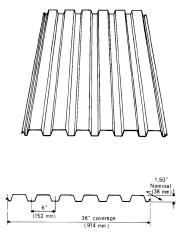Roof decks can be constructed of various materials including:
- Wood – sawed lumber, planks, plywood, or oriented strand board (OSB)
- Steel – cold rolled, corrugated
- Structural concrete – precast or poured in place
- Lightweight insulating concrete fill
- Poured gypsum concrete
- Precast gypsum
- Thermoset insulating fill
- Other composite deck materials
The most common types of roof decks in Canada are constructed of wood, structural concrete and steel.
Wood Decks
 Wood roof decks are available in three basic types:
Wood roof decks are available in three basic types:
- Composite board sheathing (up to 25 mm (1 in) nominal thickness) such as OSB, and waferboard
- Plywood
- Plank (up to 125 mm (5 in) nominal thickness)
Wood decks should be constructed of sound, air-dried or kiln-dried, solid-sawn lumber, securely fastened to joists, beams or their supports. The surface should be smooth and firm, free of cracks, knotholes, depressions or other defects.
 Steel Decks
Steel Decks
Steel roof decks are constructed of cold rolled steel sheets with ribs in each panel that provide strength and rigidity. The panels are available in a variety of profiles and gauges. The most widely used steel deck panel in commercial low slope roofing is fabricated from 22-gauge steel with a minimum yield strength of 33 ksi or Grade 33 steel with a rib depth of 38 mm (1½ in). The panels are generally attached to the supporting structure by welding or mechanical fasteners.
Because of the iron content, steel decking is susceptible to corrosion unless treated. Typically, panels are treated with a galvanized coating, or may be protected with paint, epoxy, vinyl or acrylic polymers.
Concrete Decks
The general types of structural concrete roof decks are:
- Cast-In-Place (concrete is cast at the job-site over form material and reinforced with deformed steel bars or wire mesh).
- Post-Tensioned (reinforcement cables or tendons are tensioned after the concrete has cured or set).
- Lightweight Cementitious (typically non-structural cementitious fill material poured over supporting structural panels or reinforcement).
- Precast (concrete is cast into units at the plant. Once the concrete has set, the units are transported to the job site and erected. Most precast concrete is prestressed at the manufacturing facility).
Structural concrete is produced by mixing aggregate (crushed stone or gravel) with Portland cement, water, and chemical additives. The density of reinforced structural concrete is typically in the order of 2400 kg/m³ (150 lb/ft³). Structural lightweight concrete decks include lightweight aggregates such as shale or clay used instead of some of the sand and crushed stone.
Lightweight cementitious fill decks include gypsum, lightweight aggregate and cellular concrete. Aggregates may include vermiculite or perlite.
Precast (pre-formed) decks include concrete, lightweight concrete as well as organic fibre and cement slabs. Pre-formed, ribbed asbestos roof panels have also been used as low slope decking materials.

The type of roofing materials that can be used and the way they are installed will depend on the type of deck. Each kind of deck requires its own surface preparation and precautions prior to applying the roofing materials.
